Get to Know the Cisco 220 Series Smart Plus Switches
Available Languages

Table of Contents
Introduction
The Cisco Small Business 220 Series offers a combination of powerful product performance and reliability. This series provides higher levels of security, management, and scalability you can get from a managed switch, but at the same time, giving you the affordable price of a smart switch, allowing you to enjoy the best of both experience.
Product Features
- Higher level of security and intelligence using Access Control Lists (ACLs) and Quality of Service (QoS)
- Simple and flexible management with the use of multiple options aside from the intuitive, web-based interface and Cisco FindIT utility such as the Cisco Command Line Interface (CLI), Simple Network Management Protocol (SNMP), and the Cisco Prime™ LAN Management System (LMS) integration
- Power Over Ethernet Plus allows data and power to run over a single network cable
- High performance and reliability by speeding up file transfers and providing the flexibility to manage and prioritize high-bandwidth traffic
- Optimal energy efficiency with the use of Energy Efficient Ethernet (IEEE 802.3az) and Energy Detect support
- Enhanced network security with the enhanced ACLs, port security, Guest VLANs, BPDU guard, DOS and many more
- Easy configuration and management with the use of CDP, LLDP and FindIT Network Management
- Advanced network management capabilities through CLI, Dual-image, Dual-configuration, and IPv6 support
- Additional Gigabit uplink ports
- IP telephony support
- Peace of mind and investment protection
- Cisco Limited Lifetime Hardware Warranty
- Additional service support
Product Views
Top View
The Cisco text and logo can be seen at the top of the device.
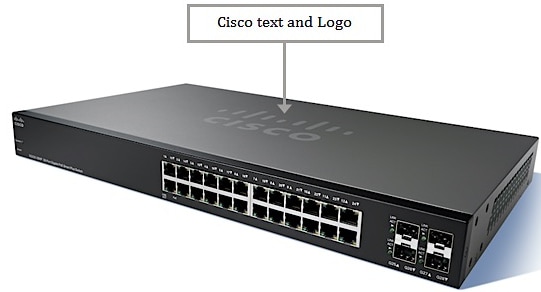
Front View
At the front panel of the device, all the ports can be seen with their LED indicators. The number of ports and the availability of the LED indicators vary depending on the exact model of your switch. The System LED and the Reset button can also be seen at the front panel.
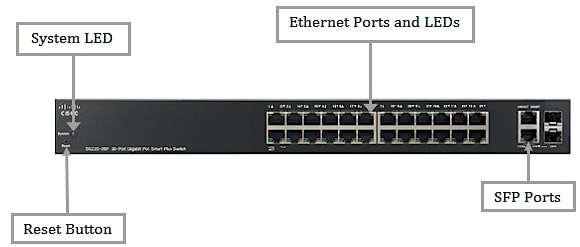
Back View
The Power and Console ports are located at the back of the device. The Console port connects the switch to the serial port of the computer using the supplied console cable.

Package Contents
Note: The actual appearance of the items below may vary depending on the exact model of your device.
 |
Sx220 Series Smart Plus Switch |
 |
Power Cord |
 |
Product CD |
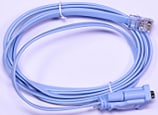 |
Console cable |
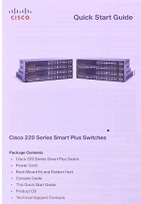 |
Quick Start Guide |
Minimum Requirements
- A switch or router that has PoE support, PoE injector, or AC power adapter
- Java-enabled web browser for the web-based configuration such as Mozilla Firefox 20 or later; Google Chrome 23 or later; Safari 5.1 or later
Default Settings
| Parameter |
Default Value |
| Username |
cisco |
| Password |
cisco |
| LAN IP Address |
DHCP address assigned by server |
| Default LAN IP |
192.168.1.254 |
Technical Details
Reset Button
The Reset button is used to reboot or reset the switch with a pin or paper clip.

System LED
This LED indicates the status of the device depending on what state it is in.

GREEN
- Steady — Lights up and remain steady when the switch is powered ON.
- Flashing — Booting up, performing self-tests, and/or acquiring an IP address.
AMBER
- Flashing — Detecting a hardware failure, a firmware failure, and/or a configuration file error.
RJ45 Ports
The RJ45 Ports or Ethernet Ports are the ports where you connect your networking devices such as computers, printers, VoIP phones, access points, and other devices. For the SF220 Series models, these ports provide speed from 10 to 100 Mbps. For the SG220 Series models, these ports provide 10 to 1000 Mbps speed.
Note: The availability of the LEDs on the RJ45 Ports described below depends on the exact model of your switch.

- LINK/ACT LED — (Green) Located on the left of the port. The light goes steady when a link between the corresponding port and other device is detected. The light flashes when the port is passing traffic.
- PoE LED (if present) — (Amber) Located on the right of the port. The light goes steady when power is being supplied to a device attached to the corresponding port.
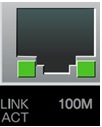
- 100M LED (if present) — (Green) Located on the right of the port. The light goes steady when another device is connected to the port, is powered on, and a 100 Mbps link is established between the devices. The light goes off when the connection speed is under 100 Mbps, or nothing is connected to the port.

- GIGABIT LED (if present) — (Green) Located on the right of the port. The light goes steady when another device is connected to the port, is powered on, and a 1000 Mbps link is established between the devices. . The light goes off when the connection speed is under 1000 Mbps, or nothing is connected to the port.
SFP Ports
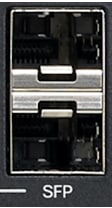
- The Small Form-Pluggable (SFP) ports are connection points for modules so that the switch can link to other switches. These ports are also commonly referred to or known as mini Gigabit Interface Converter (miniGBIC) ports.
- The SFP ports are compatible with Cisco modules MFEBX1, MFEFX1, MFELX1, MGBLH1, MGBLX1, MGBSX1, MGEBX1, and MGBT1.
- The SFP port is shared with one other RJ-45 port, called a combo port. When the SFP port is active, the adjacent RJ-45 port is disabled.
- The LEDs of the corresponding RJ-45 ports flash green to respond to the SFP port traffic.
Note: To know more about the product and hardware specifications of the Cisco 220 Series Smart Plus Switches, click here.
Related Contents
Configure 802.1X Port Authentication on the Cisco Sx220 Series Smart Switches
Configure Time-Based PoE on the Cisco 220 Series Smart Switch
Configure Time-Based Port Management in the 220 Series Smart Switch
Enable Loopback Detection on the Cisco 220 Series Smart Switch
Revision History
| Revision | Publish Date | Comments |
|---|---|---|
1.0 |
12-Dec-2018 |
Initial Release |
 Feedback
Feedback